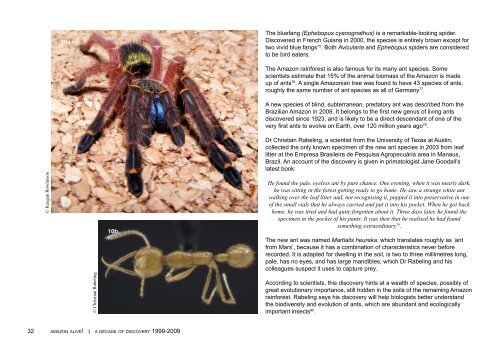Amazon Alive: A Decade of Discoveries 1999-2009 - WWF
Amazon Alive: A Decade of Discoveries 1999-2009 - WWF
Amazon Alive: A Decade of Discoveries 1999-2009 - WWF
Create successful ePaper yourself
Turn your PDF publications into a flip-book with our unique Google optimized e-Paper software.
10a.<br />
The bluefang (Ephebopus cyanognathus) is a remarkable-looking spider.<br />
Discovered in French Guiana in 2000, the species is entirely brown except for<br />
two vivid blue fangs 75 . Both Avicularia and Ephebopus spiders are considered<br />
to be bird eaters.<br />
© Keegan Rowlinson<br />
© Christian Rabeling<br />
10b.<br />
The <strong>Amazon</strong> rainforest is also famous for its many ant species. Some<br />
scientists estimate that 15% <strong>of</strong> the animal biomass <strong>of</strong> the <strong>Amazon</strong> is made<br />
up <strong>of</strong> ants 76 . A single <strong>Amazon</strong>ian tree was found to have 43 species <strong>of</strong> ants,<br />
roughly the same number <strong>of</strong> ant species as all <strong>of</strong> Germany 77 .<br />
A new species <strong>of</strong> blind, subterranean, predatory ant was described from the<br />
Brazilian <strong>Amazon</strong> in 2008. It belongs to the first new genus <strong>of</strong> living ants<br />
discovered since 1923, and is likely to be a direct descendant <strong>of</strong> one <strong>of</strong> the<br />
very first ants to evolve on Earth, over 120 million years ago 78 .<br />
Dr Christian Rabeling, a scientist from the University <strong>of</strong> Texas at Austin,<br />
collected the only known specimen <strong>of</strong> the new ant species in 2003 from leaf<br />
litter at the Empresa Brasileira de Pesquisa Agropecuária area in Manaus,<br />
Brazil. An account <strong>of</strong> the discovery is given in primatologist Jane Goodall’s<br />
latest book:<br />
He found the pale, eyeless ant by pure chance. One evening, when it was nearly dark,<br />
he was sitting in the forest getting ready to go home. He saw a strange white ant<br />
walking over the leaf litter and, not recognising it, popped it into preservative in one<br />
<strong>of</strong> the small vials that he always carried and put it into his pocket. When he got back<br />
home, he was tired and had quite forgotten about it. Three days later, he found the<br />
specimen in the pocket <strong>of</strong> his pants. It was then that he realised he had found<br />
something extraordinary 79 .<br />
The new ant was named Martialis heureka, which translates roughly as ‘ant<br />
from Mars’, because it has a combination <strong>of</strong> characteristics never before<br />
recorded. It is adapted for dwelling in the soil, is two to three millimetres long,<br />
pale, has no eyes, and has large mandibles, which Dr Rabeling and his<br />
colleagues suspect it uses to capture prey.<br />
According to scientists, this discovery hints at a wealth <strong>of</strong> species, possibly <strong>of</strong><br />
great evolutionary importance, still hidden in the soils <strong>of</strong> the remaining <strong>Amazon</strong><br />
rainforest. Rabeling says his discovery will help biologists better understand<br />
the biodiversity and evolution <strong>of</strong> ants, which are abundant and ecologically<br />
important insects 80 .<br />
32 amazon alive! I a decade <strong>of</strong> discovery <strong>1999</strong>-<strong>2009</strong>

















